mobile View, to the German Version tap the flag


- Istria (Istrien)
- former component of the Austrian-Illiric Littoral
- former Austrian crown land: Margraviate of Istria
- situated in the north of Adria on the same named peninsula
- own name in German: Istrien
- own name in Italian: Istria
- own name in Croatian: Istra
• Flags
• Meaning/Origin of the Flag
• Coat of Arms
• Meaning/Origin of the Coat of Arms
• Map of the crown lands of the Littoral
• Map of the former crown lands of Austria-Hungary (to 1918)
• Numbers and Facts
• History
• Historical Maps
• Origin of the Country's Name
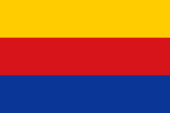
to 1918,
Flag of the country (Colours of the country),
ratio = 2:3,
Source, by:
Flags of the World



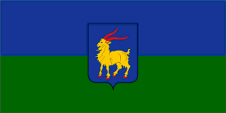
since 03.10.1994,
Flag of the Croatian District of Istria,
ratio = 1:2,
Source, by: Wikipedia (D)





The country had – like all the other crown lands of the Austrian crown – its own colours (Landesfarben), which were used amongst others on horizontally two- or three-striped flags. The colours (Landesfarben) were very often taken from the respective coat of arms of the country or were supplemented by another colour, which not appears in the coat of arms, or they went back to older models of the coat of arms (e.g. Carniola). Officially, the colours had never been regulated or stipulated, so that their sequence varied in practice or even the colors deviated. The Austrian heraldist Hugo Gerard Ströhl (1851–1919) was probably the first to take care of it and asked for the colors (Landesfarben) on the flags at the respective state authorities around 1890 and compiled them. The Crown Land of Istria used as colours of the country a flag which showed three horizontal stripes in gold, red and blue. The colours descend from the coat of arms of Istrien: blue goat-buck with red arms on a blue shield.
Source: Österreichisch-Ungarische Wappenrolle,
Flags of the World,
Volker Preuß


to 1918
Blazon of Istria,
Source, by: Ströhl, Wappenrolle Österreich-Ungarns, 1890, via austria-forum.org
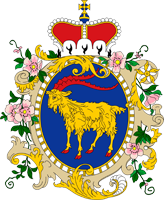
ca.1890–1918,
Coat of arms of the Margraviate of Istria,
Source, by: Ströhl, Wappenrolle Österreich-Ungarns, 1890, via Wikipedia (D)

Coat of arms of Croatia,
Source, by: Wikipedia (D)

The coat of arms of Istria shows a golden goat with red arms on a blue shield. The central image of the coat of arms goes back to the Venetians, who ruled the western part of Istria from the 9th century to 1797. The Austrian heraldist Hugo Gerard Ströhl surrounded the coat of arms ca. 1890 with Apple blossoms, to emphasize the importance of the country as a fruit-growing region. The heraldry of Istria appears since 1992 in one of the five regional scutcheons in the upper part of the coat of arms of Croatia.
Source: Österreichisch-Ungarische Wappenrolle,
Wikipedia (D),
Volker Preuß

Map ca. 1910:
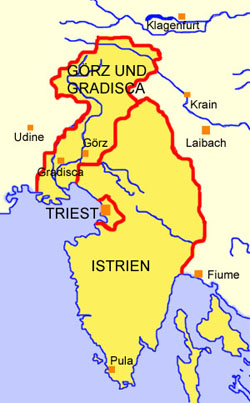
Source: Volker Preuß

Map ca. 1910:
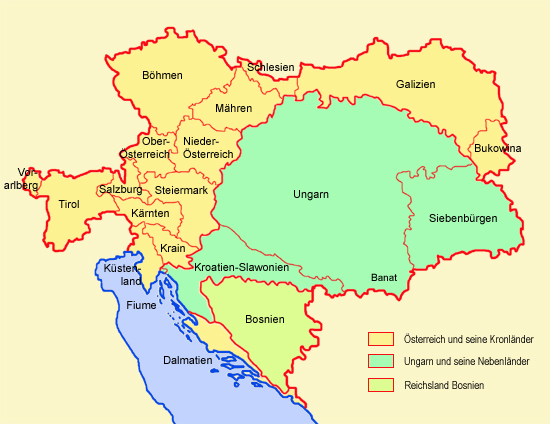
Source: Volker Preuß

Area: 1.913 square miles (1890)
Inhabitants: 317.610 (1890), thereof 44% Serbs and Croats, 37% Italians, 14% Slovenes, 2% Germans
Density of Population: 166 inh./sq.mi. (1890)
Capital: Parenz (Italian:Parenzo, nowadays Poreč), 7.368 inh. (1880), 16.696 inh. (2011)
Languages (1890): Serbo-Croatian, Slovene, Italian, German
Time Zone: MEZ
Source: Brockhaus Konversationslexikon,
Wikipedia (D)

antiquity · settlement by Celtic and Illyrian tribes
ca. 177 B.C. · the conquest of Istria by the Roman Empire is finished, to the Province of Italia
395 · at the partition of the Roman Empire today's Istria comes to the West Roman Empire (Rome)
476–489 · Istria belongs to the Empire of the Odoaker
489–545 · Istria belongs to Empire of the Eastern Goth
545–569 · Istria belongs to the East Roman Empire (Byzantium)
6th century · settlement by Slavic tribes
789 · the region becomes subjected by the Frankish Empire of the Carolingians, the region comes to the Margraviate of Friaul, the coast becomes occupied by the City of Venice for the next 1000 years
9th century · the Margraviate of Friaul comes to the new established Margraviate of Verona
952 · the Margraviate of Verona comes to Bavaria
976 · the Margraviate of Verona comes to the Duchy of Carinthia
1040 · formation of an Margraviate of Istria as a Margraviate of the Holy Roman Empire of German Nation
1077 · Istria comes partially to the Patriarchate von Aquileia
1170 · the Margraviate of Istria comes to the House of Andechs
1208 · the Margraviate of Istria comes to the House of Wittelsbach (Bavaria) and becomes ceded to the Patriarchate von Aquileia
14th century · the Counts of Gorizia (Goerz) and the House of Habsburg acquire large parts of the hinterland of Istria
1374 · vanish of the House of Goerz, the House of Habsburg acquires its territories in Istria
1797–1809 · French Revolutionar Wars, parts of Austria (Styria) become occupied by the French in 1797
12th of May 1797 · Peace of Campo Formio between Austria (House of Habsburg) and France (Napoléon I.), all Venetian possessions in Istria come to the House of Habsburg
1809 · Peace of Vienna, Austria loses Salzburg, the Inn Quarter, Western Galicia and parts of Eastern Galicia and cedes Istria, Trieste, Gorizia, Carniola, Carinthia, Croatia, and Dalmatia to France, which were merged in 1810 to the French "Illyrian Provinces"
1813 · Austria declares war on France (Napoléon), Istria is conquered back by Austria
1814/1815 · Congress of Vienna, realignment of Europe after the era Napoléon, the Empire of Austria (House of Habsburg) acquires back the in 1809 lost territories and additionally acquires the territories of the dissolved Republic of Venice in Istria; whole Istria, Trieste, Gorizia, Carinthia and Carniola become merged to the Habsburg's Kingdom of Illyria, Dalmatia and Croatia become re-annexed to Hungary (under the Habsburgs, part of the Empire of Austria)
1848/1849 · revolution in Vienna, civil war between Hungarians and Croats, riotings in Prague, Mailand and Venice, as a result of that Emperor Ferdinand I. resigns and Franz Joseph I. of Habsburg becomes new Emperor, the riotings become suppressed and he enacts a new constitution: the titular hereditary territories of the Habsburgs in the Austrian Empire become converted to crown lands with their own Landtag (parliament), the Landtag of Dalmatia rejects the annexion to Croatia, the Kingdom of Dalmatia becomes an own crown land of the Austrian crown, Croatia and Slavonia become
united to the "Kingdom of Croatia and Slavonia", which remains as a subsidiary country under the Hungarian crown, dissolution of the Kingdom of Illyria: division in the crown lands of Carniola, Carinthia, Littoral, Croatia and Slavonia and Dalmatia
1861 · new Austrian constitution, the three components of the Littoral, Margraviate of Istria, Princely County of Gorizia and Gradisca and the Imperial Free City of Trieste and its surrounding area, become own crown lands with their own parliaments, but under a common head of state, the governor of the Austrian-Illiric Littoral with his seat in Trieste
1914–1918 · First World War, thereafter breakdown of the imperial-royal monarchy, disintegration of Austria-Hungary in national states
10th of September 1919 · Treaty of Peace of Saint-Germain after the First World War, Austria has to cede Istria to Italy, affiliated to Italy as "Provincia di Istria"
1939–1945 · Second World War, in Istria fight between 1941 and 1945 Croatian and Slovanian partisans for an annexion of Istria by Yugoslavia
13th of October 1943 · capitulation of Italy, as a result of that the German Empire occupys all other Istria territories
1945 · conquest and occupation of the area by Yugoslav partisans at the end of the Second World War, expulsion and partially even assassination of the largest part of the in the country remained German and Italian civilian population
29th of November 1945 · proclamation of the "Federative People's Republic of Yugoslavia" (incl. Istria), Istria comes in this way mainly to Croatia, the northwest comes to the independent state "Free Town of Triest"
1954 · the area of the Free Town of Triest becomes shared out between Italy and Yugoslavia (Slovenia and Croatia)
1975 · Treaty of Osimo between Italy and Yugoslavia, adjustment of the exact course of the border boundary, protection of the Italian minority within Yugoslavia
25th of June 1991 · Slovenia and Croatia declare its independence from Yugoslavia
Source: Atlas zur Geschichte,
Wikipedia (D),
RetroBib Retrobibliothek,
Discovery '97,
Volker Preuß

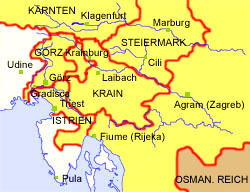
ca. 1526
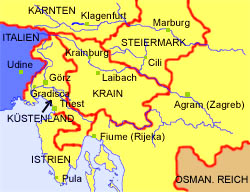
1849
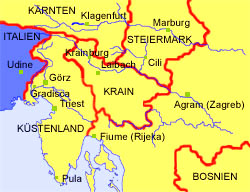
1880
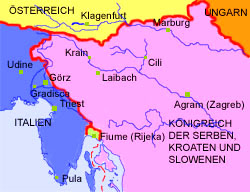
1921
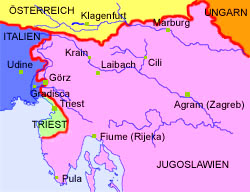
1950
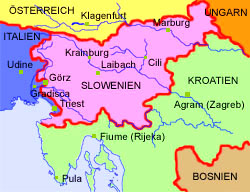
2005
Maps: Volker Preuß

The name "Istria" goes back to the Illyrian people of the "Histri" who lived here in antiquity. The name was given by the Romans, who conquered the country in 177 B.C. For them, the Illyrian inhabitants of the peninsula were pirates. Since there are no linguistic bequests of the Histri, you can, if you want, find the Latin word "Histrionia" in the word "Histri", which means "acting". This may have been a reference to the inventive piracy of the Illyrian inhabitants of the peninsula at that time, and not the real name of the people who originally lived here.
Source: Wikipedia (D),
Ausführliches und möglichst vollständiges deutsch-lateinisches Lexicon, von Immanuel Johann Gerhard Scheller, Leipzig, 1789,
Volker Preuß

Further Austria pages (historical flags and coats of arms):
• Empire of the Austrian Habsburgs (to 1804)
• Empire of Austria (1814–1867)
• Austria-Hungary (1867–1918)
• Republic of Austria (since 1918)

![]()


















